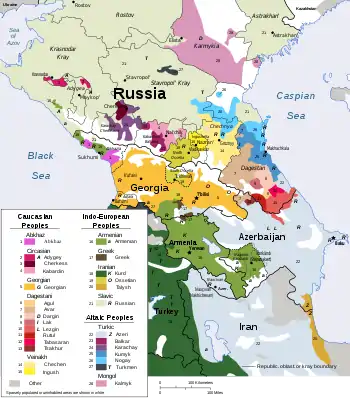Kryts language
Kryts (Kryc) is a Samur language of the Northeast Caucasian language family spoken in parts of the Quba Rayon of Azerbaijan by 6,000 people in 1975.[3] Its dialects are Kryts, Jek, Khaput, Yergyudzh, and Alyk, which are all quite distinct to the point of only partial mutual intelligibility, therefore they could also be considered separate languages in a dialect continuum.[3]
| Kryts | |
|---|---|
| кърыцIаь мез ġrəċä mez | |
| цIека meз ċeka mez | |
| Native to | Azerbaijan |
| Region | Quba Rayon |
| Ethnicity | Kryts |
Native speakers | 5,000 (2007)[1] |
| Language codes | |
| ISO 639-3 | kry |
| Glottolog | kryt1240 |
| ELP | Kryts[2] |
Kryts is endangered,[4][5] classified as "severely endangered" by UNESCO's Atlas of the World's Languages in Danger.[6]
Phonology
Consonants
| Labial | Alveolar | Palatal | Velar | Uvular | Pharyngeal/ Epiglottal |
Glottal | ||||||
|---|---|---|---|---|---|---|---|---|---|---|---|---|
| plain | lab. | pal. | plain | lab. | pal. | |||||||
| Stop | voiceless | p | t | k | kʷ | kʲ | q | qʷ | qʲ | ʔ | ||
| ejective | pʼ | tʼ | kʼ | kʼʷ | kʼʲ | qʼ | qʼʷ | qʼʲ | ||||
| voiced | b | d | ɡ | ɡʷ | (ɢ) | |||||||
| Affricate | voiceless | (t͡s) | t͡ʃ | |||||||||
| ejective | t͡sʼ | t͡ʃʼ | ||||||||||
| voiced | (d͡z) | d͡ʒ | ||||||||||
| Fricative | voiceless | f | s | ʃ | x | χ | (ʜ) | h | ||||
| voiced | v | z | ʒ | ɣ | ʁ | ʁʷ | ʕ | |||||
| Nasal | m | n | ||||||||||
| Trill | r | |||||||||||
| Approximant | l | j | ||||||||||
- /ʁ/ may also be realized as [ɢ] or [qː], in complementary distribution.
- Sounds /t͡s, d͡z/ only occur in other dialects of the language.
- An /h/ may vary from a glottal sound to an epiglottal fricative /ʜ/.
References
- Authier, Gilles. 2009. Grammaire kryz. Paris: Peeters.
- Kryts at Ethnologue (18th ed., 2015)
- Endangered Languages Project data for Kryts.
- Ethnologue entry for Kryts
- "Kryts". The Endangered Languages Project.
- "UNESCO Atlas of the World's Languages in Danger". UNESCO.
- UNESCO Interactive Atlas of the World’s Languages in Danger Archived February 17, 2010, at the Wayback Machine
This article is issued from Wikipedia. The text is licensed under Creative Commons - Attribution - Sharealike. Additional terms may apply for the media files.
